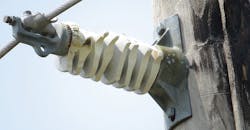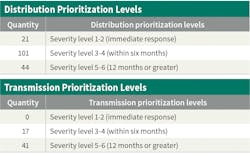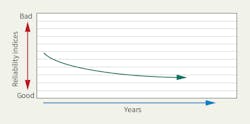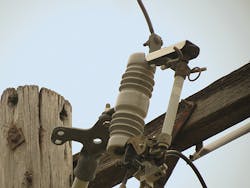Ultrasound Testing for Worst-Performing Circuit Analysis
While providing reliable service to Kansas City Power & Light and Westar Energy customers is at the heart of everything the utilities do, the ability to positively identify all failing equipment, right before it fails, is nearly impossible. Typically, as soon as a circuit experiences its second outage event, it is labeled a bad actor or a worst-performing circuit (WPC).
Traditional patrol methods do not always catch electrical equipment failure before being detected. By then, it is too late to act. Using ultrasound technology, equipment failure can be detected sooner now, enabling Kansas City Power & Light (KCP&L) and Westar to provide customers more reliable service.
Using ultrasound detection technology to examine condition is not new to healthcare and manufacturing industries, but it is relatively new in the electric utility industry. Utilities think about sound detection when looking for electrical arcing. While some utilities use radio frequency (RF) detection equipment, the pure sound of an ultrasound wave makes it easier to pinpoint electrical arcing because the sound wave travels through the material.
A Pure Sound Wave
In practice, the tool detects ultrasound waves that exceed the range of hearing frequencies in the 20-kHz to 100-kHz range. The decibel level measurements quantify the intensity level of the sound produced from turbulence, friction or escaping gas. Ultrasound is a pure sound wave that travels through material with frequencies higher than the upper audible limit of human hearing and makes it easier to locate the failed equipment in the field. Ultrasound detection can be used in low-, medium- and high-voltage systems. KCP&L and Westar use the tool on both medium (2.4-kV to 34-kV) and high (69-kV) voltages.
The tool can sense other types of sound vibrations for the user, including the ability to find faults, air leaks, steam trap faults, electrical phenomena such as corona and potential arc flash hazards. The asset management group at KCP&L and Westar concentrated their efforts on the potential arc flash hazard generated from failing electrical equipment. Three fundamental electrical problems can be detected by ultrasound:
- Arcing — An arc occurs when electricity flows through space. Lightning is a good example.
- Corona — When voltage is applied on an electrical conductor —for example, when the high-voltage transmission line exceeds threshold values — the air around it starts to ionize to form a blue or purple glow.
- Tracking — Often referred to as micro-arcing, this follows the path to the damaged insulator.
KCP&L and Westar contracted with Specialized Energy Consultants (SEC) to perform ultrasound testing on all its WPCs. SEC is a leading ultrasound detection firm with immense experience in testing electrical structures on several continents, including Asia, Australia and North America.
Validation Process
The validation process included two 25-kV distribution systems located in different areas of the territory, which were listed as WPCs for multiple years. One such circuit was 50 circuit miles (80 km) of distribution lines exposed to the environments and served power to nine rural communities with combined customer counts of about 2583.
Field employees responding to outage events in these areas had reported the causes as unknown. These unknown causes contributed to 6964 customers interrupted and more than 1.5 million customer minutes of combined interruptions. The customer average interruption duration index (CAIDI) for these combined areas was 222.5 minutes.
Nearly 43,700 customers were affected multiple times in the previous years by outages as a result of unknown causes. This resulted in more than 4.36 million customer minutes interrupted. These factors led to the decision to search for inspection alternatives, which led to ultrasound technology.
This was the primary question asked before using ultrasound: Would this type of technology work in KCP&L and Westar’s environment? Investigation strengthened the belief ultrasound technology could improve testing practices in four reliability program areas: better forecast methods, improved maintenance practices, substantial reliability improvements and better pinpointing of equipment failure.
The scope of work was as follows:
- WPCs
- Repeater WPCs
- Limited Tier I circuits.
However, the scope was limited to overhead feeder class construction and did not include circuit laterals. The second test was designed to identify the severity levels of sounds discharged from failing equipment as a result of various causes. Could the technology detect equipment conditions at voltage levels distinct in KCP&L and Westar’s distribution systems? Could failure rates be quantified using frequency counts?
Severity level is the level of sound measured in decibels at various kilohertz levels from sound intensity measurements established by SEC. Of the 4114 structures tested, 166 defects were discovered, a 4.1% defect ratio. Prioritization levels were determined using SEC’s methodology and helped to prioritize construction work. While severity levels were used to plan the sequence of work, all severity levels were mitigated.
A similar approach was applied to the 69-kV transmission voltage to validate the prioritization levels. The testing process entailed reviewing 669 structures, resulting in the discovery of 58 defects, or an 8.67% defect ratio. As with distribution, severity levels were used to prioritize construction work and all severity levels were mitigated.
Benefit-to-Cost Assumptions
From 2015 to 2017, SEC has tested 31,104 KCP&L structures and discovered 485 equipment defects, equal to a failure ratio of 1.56%. Insulators ranked the highest regarding number of defects. Most of the insulator failures were attributed to broken, cracked or flashed-over units. They also represented the most significant detrimental effect when associated with circuit feeder health.
The utility achieved its lowest system average interruption frequency index (SAIFI) and system average interruption duration index (SAIDI) reported. These metrics continue to improve as a result of ultrasound testing.
The justification for budget funds to avoid an outage event proves challenging to measure, because the outage event has not happened yet. The challenge in using traditional costing practices with the ultrasound testing process is they are based on a reactive approach, when ultrasound testing is proactive. This makes it difficult to justify an ultrasound testing program. The assumption used in the benefit-to-cost ratio model blends the proactive and reactive costs mechanism to include circuit revenue. A benefit-to-cost ratio above 1 indicates the testing process can justify the expenditure. The following analysis was used to calculate a benefit-to-cost ratio of 1.3:
- While the total reactive repair costs for all total units (n) to be remediated is estimated to be roughly the total ultrasound testing costs, the assumption is the proactive repair cost is equal to the reactive repair cost.
- Average hourly lost revenue outage cost of circuit A is $Revenue, based on an annual revenue of $Revenue.
- Planned outages and unplanned outages have equal lost revenue per hour.
- Planned outages take approximately 50% less time to complete repairs because they are scheduled proactively.
- The following benefit-to-cost ratio equation was used:
Lessons Learned
Ultrasound technology outperformed the traditional patrol processes, resulting in a 30% to 40% improvement in finding failed equipment. Ultrasound technology offers a better solution to score equipment conditions using a prioritization scale measured by sound wave intensity. The signal — generated from electrical arcing sensed by the tool — is more efficient than the naked eye and key to the success of this testing program. The costs of not finding these failures can lead to millions of dollars of unnecessary capital expenditures and fewer improvement opportunities.
KCP&L and Westar also found ultrasound technology reduces customer complaints. The utilities consistently experienced shorter outage events using the testing process. Without it, the second and third outage events used to plague the budget. More importantly, customer satisfaction improved along with community relationships.
Critical business objectives were accomplished with the ultrasound testing program:
- Improved reliability at the circuit level
- Dependable inspection process to uncover all hidden defects
- Pinpoint causes for equipment failures
- Reduced number of unknown causes from re-fusing events on the same circuits.
Acknowledgement
The ultrasound testing process was a team effort and the authors would like to thank those who made it a success story: Emeka Anyanwu, Jeff Wolf and Kevin Noblet as well as field personnel who migrated the repairs.
For more information:
KCP&L | www.kcpl.com
SEC | www.s-e-consultants.com
Westar | www.westarenergy.com
About the Author
Bob.Gaw
Bob Gaw is senior project manager of distribution asset management at Kansas City Power & Light. He has 44 years of electrical utility experience and is responsible for the worst-performing circuits, lateral improvement program and other reliability system initiatives. He has a MBA degree in finance from Baker University. He is a journeyman lineman, operation supervisor and is a certified Six Sigma Master Black Belt.





